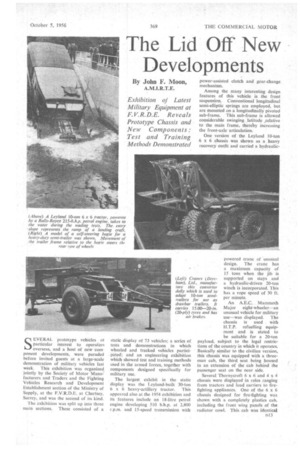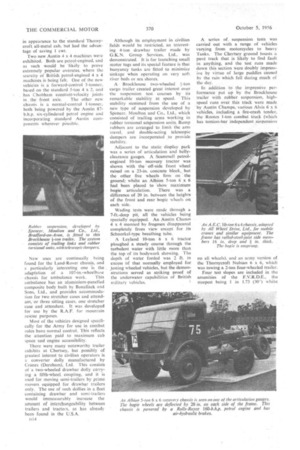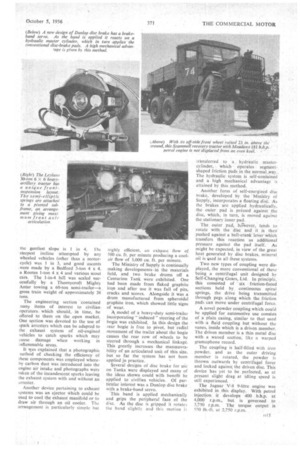The Lid Off New evelopments
Page 53

Page 54

Page 55

If you've noticed an error in this article please click here to report it so we can fix it.
By John F. Moon,
A.M.I.R.T.E.
Exhibition of Latest Military Equipment at F.V.R.D.E. Reveals Prototype Chassis and New Components : Test and Training Methods Demonstrated
sEVERAL prototype vehicles ol particular interest to operators overseas, and a host of new cont ponent developments, were paraded before invited guests at a large-scale demonstration of military vehicles last week. This exhibition was organized jointly by the Society of Motor Mani): facturers and Traders and the Fighting Vehicles Research and Development Establishment section of the Ministry of Supply, at the F.V.R.D.E. at Chertsey, Surrey, and was the second of its kind.
The exhibition was split up into three main sections. These consisted of a
static display of 73 vehicles; a series of tests and demonstrations in which wheeled and tracked vehicles participated; and an engineering exhibition which showed test and training methods used in the armed forces, together with components designed specifically for military use.
The largest exhibit in the static display was the Leyland-built 30-ton 6 x 6 heavy-artillery tractor. This appeared also at the 1954 exhibition and its features include an 18-litre petrol engine developing 510 b.h.p. at 2,800 r.p.m. and 15-speed transmission with power-assisted clutch and gear-change mechanism.
Among the many interesting design features of this vehicle is the front suspension. Conventional longitudinal semi-elliptic springs are employed, but are mounted on a longitudinally pivoted sub-frame. This sub-frame is allowed considerable swinging latitude ,relative to the main framc, thereby increasing the front-axle articulation.
One version of the Leyland 10-ton 6 x 6 chassis was shown as a heavy recovery outfit and carried a hydraulic powered crane of unusual design. The crane has a maximum capacity of 15 tons when the jib is supported on stays and a hydraulic-driven 20-ton winch is incorporated. This has a rope speed of 30 ft. per minute.
An A.E.C. Mammoth Major eight-wheeler—an unusual vehicle for military use—was displayed. The chassis is used with H.T.P. refuelling equipment and is stated to be suitable for a 20-ton payload, subject to the legal restrictions of the country in which it operates. Basically similar to the civilian version, this chassis was equipped with a threeman cab, the third seat being housed in an extension of the cab behind the passenger seat on the near side.
Several Thorn ycroft 6 x 6 and 4 x 4 chassis were displayed in roles ranging from tractors and load carriers to firefighting appliances. One of the 6 x 6 chassis designed for fire-fighting was shown with a completely plastics cab, including the front wing panels of the radiator cowl. This cab was identical n13
in appearance to the standard Thornycroft all-metal cab, but had the advantage of saving 1 cwt.
Two new Austin 4 x 4 machines were exhibited. Both are petrol-engined, and as such would be 'likely to prove extremely popular overseas, where the scarcity of British petrol-engined 4 x 4 machines is being felt. One of the new vehicles is a forward-control 3-tonner. based on the standard 5-ton 4 x 2, and has .Chohham constant-velocity joints
in the front axle. The other new chassis is a normal-control 1-tonner, both being powered by the Austin 87b.h.p. six-cylindered petrol engine and incorporating standard Austin components wherever possible.
New uses are continually being found for the Land-Rover chassis, and a particularly interesting one is the adaptation of a 107-in,-wheelbase chassis for ambulance work. This ambulance has an aluminium-panelled composite body built by Bonallack and Sons, Ltd., and provides accommodation for two stretcher cases and attendant, or three sitting cases, one stretcher case and attendant. It was developed for use by the R.A.F. for mountain rescue purposes.
Most of the vehicles designed specifically for the Army for use in combat roles have normal control. This reflects the attention paid to maximum cab space and engine accessibility.
There were many noteworthy trailer exhibits at Chertsey, but possibly of greatest interest to civilian operators is a converter dolly manufactured by Cranes (Dereham), Ltd. This consists of a two-wheeled drawbar dolly carrying a fifth-wheel, coupling, and it is used for moving semi-trailers by prime movers equipped for drawbar trailers only. The use of such dollies in a fleet containing drawbar and semi-trailers would immeasurably increase the amount of interchangeability between trailers and tractors, as has already been found in the U.S.A.
D14 Although its employment in civilian fields would be restricted, an interesting 4-ton drawbar trailer made by G.K.N. Group Services, Ltd., was demonstrated. It is for launching small motor tugs and its special feature is that buoyancy tanks are fitted to minimize sinkage when operating on very soft. river beds or sea shores.
A Brock house two-wheeled ',ton cargo trailer created great interest over the suspension test. courses by its remarkable stability at speed. This stability stemmed from the use of a new type of suspension developed by Spencer. Moulton and Co., Ltd., which consisted of trailing arms working in rubber torsional suspension units. Bump rubbers are arranged to limit the arm travel, and double-acting telescopic dampers are incorporated to provide stability.
Adjacent to the static display park was a series of articulation and bellyclearance gauges. A Scammell petrolengined 10-ton recovery tractor was shown with the off-side front wheel raised on a 23-in, concrete block, but the other five wheels firm on the ground; whilst an Albion 5-ton 6 x 6 had been placed to 'show maximum bogie articulation. There was a difference of 20 in. between the heights of the front and rear bogie wheels on each side.
Wading tests were made through a 7-ft.-deep pit, all the vehicles being specially equipped. An Austin Chamo 4 x 4 manned by frogmen disappeared completely from view except for its Schnorkel-type breathing tube.
A Leyland 10-ton 6 x 6 tractor ploughed a steady course through the turbulent water with little more than the top of its bodywork showing. The depth of water forded was 2 ft. in excess 'of that normally employed for testing wheeled vehicles, but the demonstrations served as striking proof of the underwater capabilities of British military vehicles. A series of. suspension tests was carried out with a range of vehicles varying from motorcycles to heavy Tanks. The Chertsey ground boasts a pave track that is likely to find fault in anything, and the test runs made down this section were doubly impressive by virtue of large puddles caused by the rain which fell during much of the day.
In addition to the impressive performance put up by the Brockhouse trailer with rubber suspension, highspeed runs over this track were made by Austin Champs, various Alvis 6 x 6 vehicles, including a fire-crash tender, the }Wales 1-ton combat truck (which has torsion-bar independent suspension
on all wheels), and an army version of the Thornycroft Nubian 6 x 6, which was towing a 2-ton four-wheeled trailer.
Four test slopes are included in the amenities of the F.V.R.D.E., the steepest being 1 in 1.73 (30') whilst the gentlest slope is 1 in 4. Thc steepest incline attempted by any wheeled vehicles (other than a motorcycle) was 1 in 3, and goad ascents . were made by a Bedford 3-ton 4 x 4. a Rootes 1-ton 4 x 4 and various scout cars. The 1-in-4 hill was scaled successfully by a Thornycroft Mighty Antar towing a 60-ton semi-trailer—a gross train weight of approximately 38 tons.
The engineering section contained many items of interest to civilian operators which should, in time, he offered to them on the open market. One section was devoted to the use of spark arresters which can be adapted to the exhaust system of oil-engined vehicles to catch sparks which may cause damage when working in inflammable areas.
It was explained that a photographic nethod of checking the efficiency of these components was employed whereby carbon dust was introduced into the engine air intake and photographs were taken of the incandescent sparks leaving the exhaust system with and without an arrester.
Another device pertaining to exhaust systems was an ejector which could be used to cool the exhaust manifold or to draw air through an oil cooler. The arrangement is particularly simple but
nighly efficient, an exhaust flow of 500 Cu. ft. per minute proaucing a coolair flow of 3,000 cu. ft. per minute.
The Ministry of Supply is continually making developments ,in the materials field, and two brake drums off a Centurion Tank were exhibited_ One had been made from flaked graphite iron and after use it was full of pits, cracks and scores. Alongside it was a drum manufactured from spheroidal graphite iron, which showed little signs of wear,
A, model of a heavy-duty semi-trailer incorporating " induced" steering of the bogie was exhibited. In this design the rear bogie is free to pivot, but radial movement of the trailer about the bogie causes the rear row of wheels to he steered through a mechanical linkage. This greatly increases the manceuvrability of an articulated unit of this size, but so far the system has not been applied in practice.
Several designs of disc brake for use on Tanks were displayed and many of the ideas shown could with benefit be applied to civilian vehicles. Of particular interest was a Dunlop disc brake with a brake-band servo.
This band is applied mechanically and grips the peripheral face of the disc. As the disc is gripped it rotates the hand slightly and this motion transferred to a hydraulic mastercylinder, which operates segmentshaped friction pads in the normal_way. The hydraulic system is self-contained and a high mechanical advantage is attained by this method.
Another form of self-energized disc brake, developed by the Ministry of Supply, incorporates a floating disc. As the brakes are applied hydraulically, the outer pad is pressed against the disc, which, in turn, is moved against the stationary inner pad.
The outer pad, hi7wever, tends to rotate with the disc and it is then pushed against a bell-crank lever which transfers this reaction as additional pressure against the pad itself. As might be expected, in view of the great heat generated by disc brakes, mineral oil is used in all these systems.
Two new types of coupling were displayed, the more conventional of these • being a centrifugal unit designed by Self-Changing Gears, Ltd. In principle. this consisted of " six friction-faced sections held by continuous spiral springs, the drive being transmitted through pegs along which the friction pads can move under centrifugal force.
A novel powder coupling which could bc applied for automotive use consists of a plain casing, similar to that used with a fluid coupling but without the vanes, inside which is a driven member. The driven member is a thin metal disc with a waved section,' like a warped gramophone record.
The coupling is half-filled with iron powder, and as the outer driving member is rotated, the powder is thrown outwards by centrifugal force and locked against the driven' disc. This device has yet to be perfected, as at present slight drag at idling speed is still experienced. • The Jaguar V-8 9-litre engine was exhibited in this display. With petrol injection it develops 400 b.h.p. at 4,000 r.p.m., but is governed to 3,750 r.p.m. The torque output is 550 lb.-ft. at 2,750 r.p.m.
















































































































